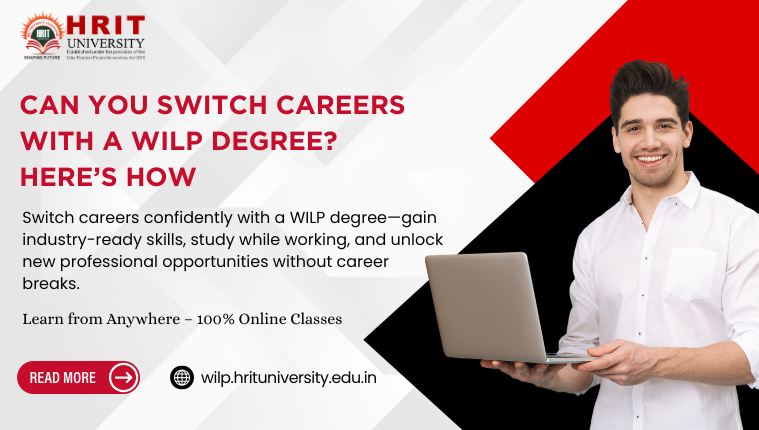Career changes are no longer rare, risky leaps they once had. Today’s sharp transport, technology -driven finances, professional exchange industries or job tasks many times during their careers, sometimes without need, sometimes without need.
If you are considering the axis of a great career, but the full -time study may not be far from your current job, Work Integrated Teaching Programs (WILP) provides a practical and fast popular route. But the big question is, can a column row actually help you change your career? Short answer: Yes, if you contact it strategically. Let’s see how
1. Understanding WILP: Learning Without Leaving Your Job
A task integrated teaching program mixes educational studies with real professional work. Instead of quitting your job to study, use real -time concepts with your current role.
For example, you can work in sales, but at the same time pursue a will in computer science. Today’s work pays bills, while your courses gradually create the skills required for your new career path.
Important features of Wilp:
- Flexibility: Learn without career gaps.
- Industry Relevance: Course is designed for immediate application in the workplace.
- Accreditation: Many WILPs are UGC week-known and recognized by employers.
2. Why WILP Works for Career Switching
Changing a career is often about closing the skills difference where you are and where you want to be. The Willp program addresses it directly through it:
a) Targeted Skill Development
Villaps is usually designed for the industry. If you aim to move it from marketing, you can choose a software development program, AI or cyber security – in search of yourself really employers.
b) Real-Time Application
Unlike traditional class degrees, Willa lets you test and refine new skills at work immediately. It not only cement learning, but also gives you specific examples for interviews and portfolio.
c) Continuous Income
Because you are still working, you avoid financial stress – an important factor that prevents many people from changing their careers.
3. Step-by-Step: Using WILP to Switch Careers
Step 1: Define Your Target Career Path
Before you sign up, the crystals are clear where you want to go. Another learning plan is required to switch from HR to Ui/UX design from production to supply chain analysis.
Step 2: Research WILP Programs
Not all programs are the same. Look for:
- UGC or equivalent recognition (degree ensures validity)
- Industry Binding (location, internship, certificate)
- Relevant competence for the desired field
- Flexibility in exam and planning
Step 3: Build a Transition Plan
- Short-term: Get basic skills through courses.
- Mid-term: Start taking related projects on your current job.
- Long-term: Once you have experienced, you must work out a role in the internal or external for change.
Step 4: Create a Portfolio
When studying, you compile your work – case studies, code samples, reports or designs. Employers love evidence of applied learning.
4. Overcoming Common Career-Switch Challenges with WILP
Challenge 1: “I don’t have experience in the new field.”
Solution: Use your Willpage projects as a practical experience. Many programs include Capstone, Internship or Live Industry projects that you can view.
Challenge 2: “Employers did not matter to my online or part -time degree.”
Solution: Choose a reputable institution. Accreditation means more than distribution mode. Highlight real -world projects and skills.
Challenge 3: “I’m afraid I will start with scratches.”
Solution: Utilizing transferable skills communication, management, problem solving and while adding technical expertise through your will. This hybrid skills kit can make you stand out.
5. Real-Life Example: A Career Pivot in Action
Think of Anita, a 32 -year -old mechanical engineer works in construction. She wanted to go into data analysis, but she couldn’t take the risk of quitting the job. He joined a will in computer science, spent the evening learning python, statistics and machine learning.
For two years he began using analysis technology for production data in his current company. This not only provided the experiences of her hands, but also made her a valuable internal expert. When he completed his willingness, he exceeded a full-time data analyst role with B.tech For Working Professional who took a career break ever.
6. Industries Where WILP Can Help You Switch
- IT and software: Programming, Cloud Computing, Cyber Security
- Data and analysis: Data Science, Business Analytics, AI
- Management: MBA expertise in marketing, Finance, HR
- Engineering: Citizen, Mechanical, Power Experture
- Design and Creative: UX/UI design, digital media
- Supply Series and Logistics: Operation, Buy
7. Tips for Maximizing WILP for Career Change
- Network classmates in your program – often have industry connections.
- Document everything – keep track of projects, reactions and results.
- Look for mentorship – find someone in the goal industry for guidance.
- Stay Update – Complement your Willpage with small courses or certificates.
- Communicate with your employer – they can support your switch internally.
8. The Mindset Shift: Patience & Persistence
A mermaid degree is a powerful tool, but it is not magic. Career change is a process that requires:
- Time: You may need 1-3 years for infection.
- Efforts: Work, studies and balanced personal life are demanding.
- Adaptability: You can start in an input or hybrid role before switching completely.
Remember that a willing degree opens the doors – but you still have to go through them.
WILP Degree After Diploma: A Smart Move for Working Technicians
Conclusion
Yes, you can completely change a career with a willing degree. To strategically select your program, use real -time skills, build a portfolio and take advantage of your network, you can find your current role and gap between your dream career – without refraining by your income or professional speed.
In the developing labor market, adaptability is your largest property. A willpower, when used with care, is more than just an academic identification – this is a launch plate for your next chapter.

